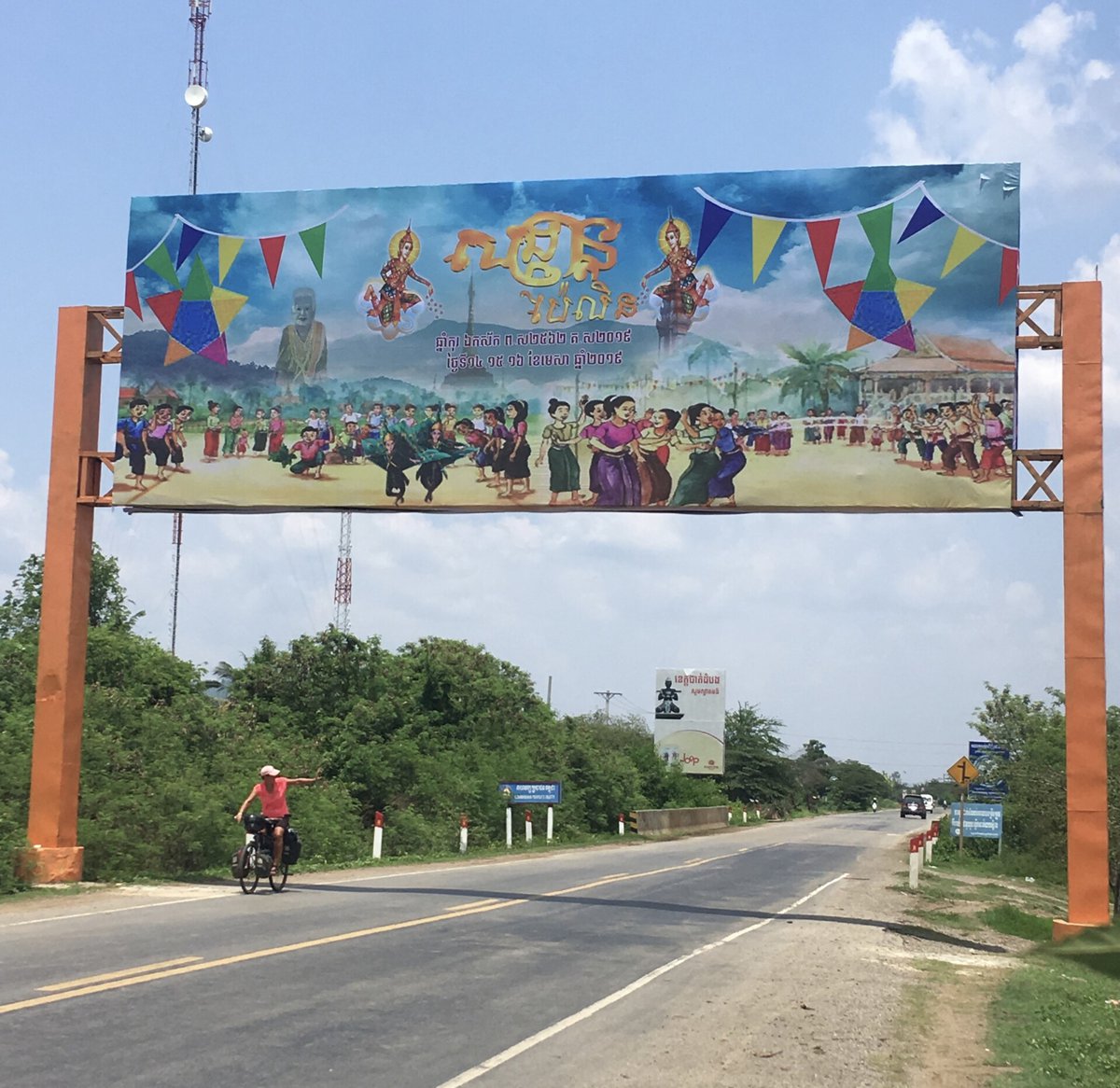Published on April 15, 2019 at 8:09 AM
Published on April 15, 2019 at 8:09 AM
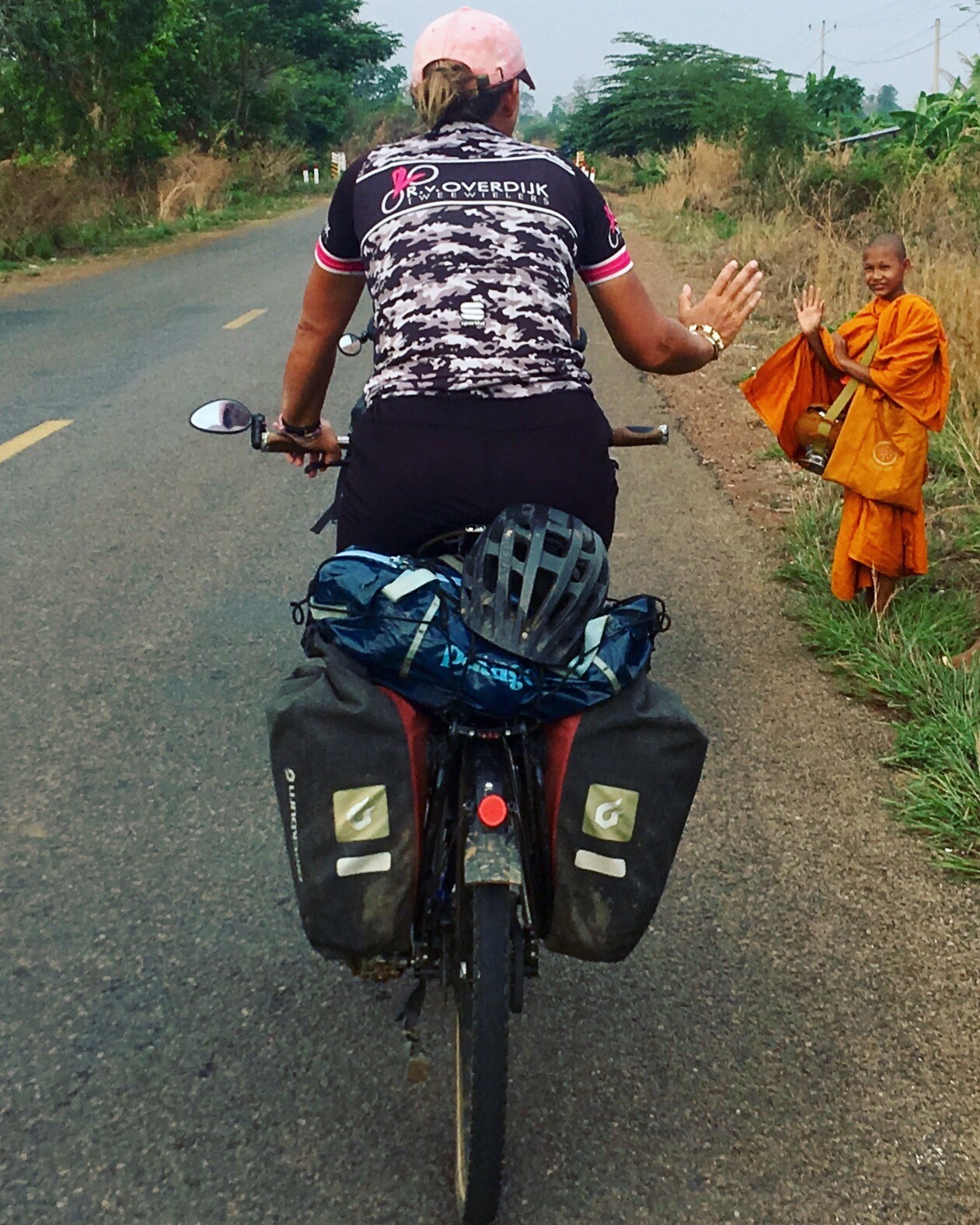
After 6 weeks in Laos we arrive at the border with Cambodia. For the first time we are not looking forward to a new country. Not because we are tired of traveling, certainly not! But Cambodia is a hot country and April is a hot month. It is the country to traverse on the way back to Thailand, to Bangkok where we meet our children. A country in between to get from A to B. And most of all, a country which is according to others cyclists quite boring to cycle through. Our normal curiosity for a relatively unknown country is in this case rather limited. The massive temple complex Angkor Wat, near the city of Siem Reap, is an absolute tourist highlight. The desire to visit that temple area and to get in Bangkok in time determines our cycling route through Cambodia. We plan a short route from South Laos back to Thailand with a visit to Angkor Wat.
There are many stories about the border crossing between Laos and Cambodia, most are about the fact that you have to pay an extra dollar here and there. Apparently the officers do not really earn much and use their power to earn a little extra by asking one or two dolar for the free stamp. Principal travelers sometimes spend several hours waiting and not paying. We arrive with a concern of a different order. We have enough money on us but it is Laotian and apparently we can only pay with US dollars. There is no exchange office, no ATM and there is no border town. There is actually damn little at the border. Okay, it might be an example of too little prior orientation (or too much life in the here and now). There is nothing else to do than buy dollars from the man who is probably the guide of the group of tourists that hangs around. A win-win situation: he earns well and we are helped enormously and are able to continue.
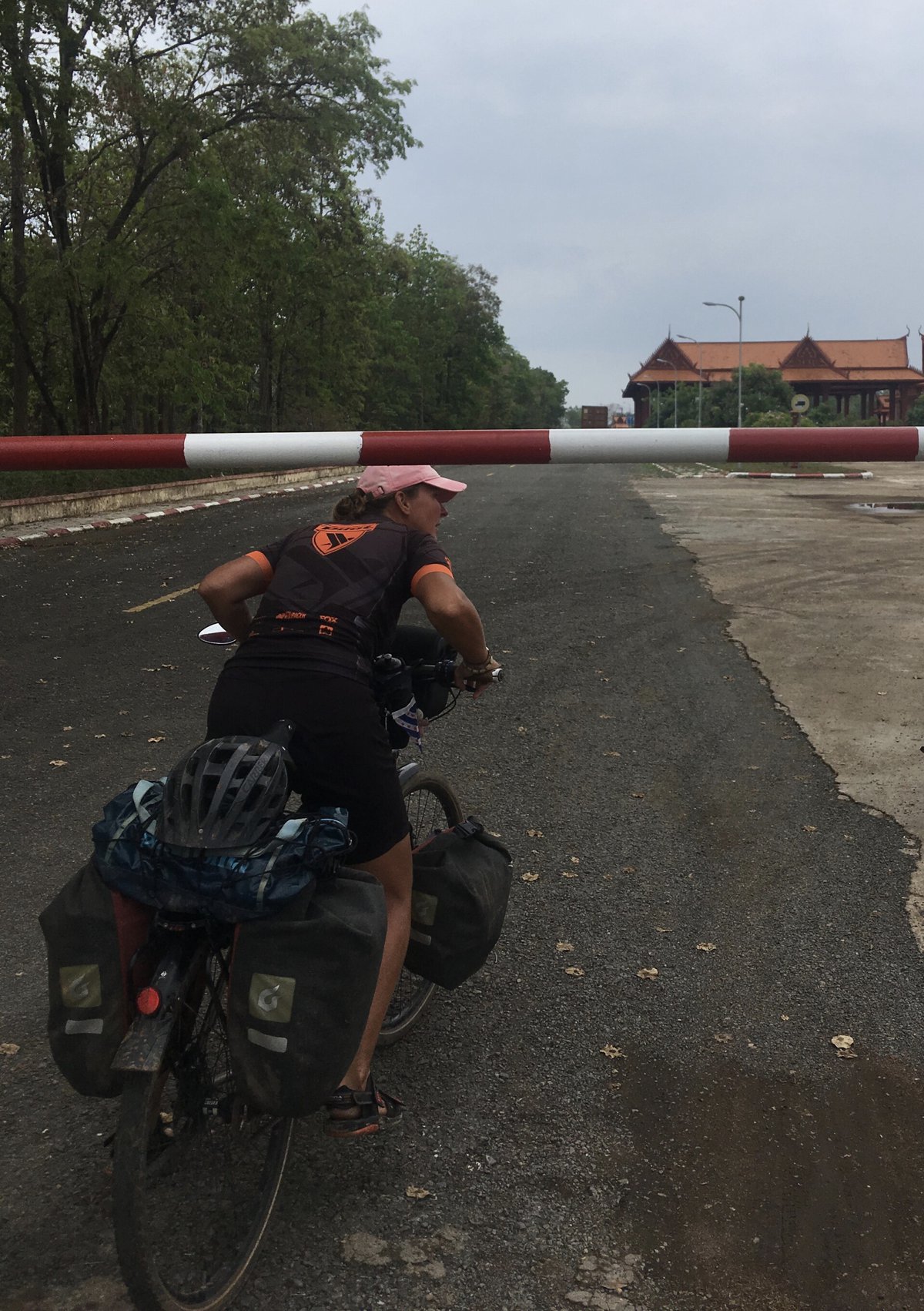
Just before the border we meet Stefan who left home at about the same time (Leipzig, Germany) as we left Oirschot and cycled roughly the same route. In Turkey a friend joined him and he only recently stopped (Vientiane, Laos) to go back home. Stefan cycles on to Bangkok and then returns home. Exchanging stories makes waiting at customs pleasant.
The temperature and the road after the border crossing turn out to be less pleasant. After an hour and a half of indoor border paperwork, it appears that the early morning clouds have completely dissolved and the almost acceptable temperature has risen to the now well-known sticky heat. Here and there the road is still paved, but large parts of the boring, straight, flat road consist of rubble, boulders and sand. Keeping eyes on the road, but there is nothing to see or miss this time: no mountain, no animal, no village, no house, no person, not even a passing truck. We only set a good pace to get rid of this dullness as quickly as possible.
The first village of any significance is also a small town: Stung Treng or ក្រុង ស្ទឹងត្រែង. The Cambodian alphabet is a bit harder and more elegant than Burmese, Thai and Laotian, but since we have not learned to read it, this time too we are saving ourselves the trouble of deciphering the alphabet. We check in at a guesthouse and are told at the reception that the room rate is US $ 15, that the Cambodian currency is called “riel” and the price in riel is the dollar price x 4000. We have a few dollars left from the border, pay the amount and immediately ask where we can find an ATM to count ourselves rich in Cambodian riel. Strangely enough, only brand new US dollar bills come out of the machine and whatever we try: no local riel.
The guesthouse has wifi and we look (yes, only now) on how that works in Cambodia with money. The US dollar appears to be the usual currency for larger amounts and for smaller amounts below one dollar they switch to the riel banknotes. But really large amounts are not that common and we are immediately confronted with the problem that we have received two 100-dollar bills from the ATM that no one can (or want to) change. We read (yes, only now) that at an ATM with a foreign bank card you always get paid in dollars and if possible in $ 100 banknotes. For example, the tip is to pin $ 190 instead of $ 200. When we eat in a restaurant together with Stefan in the evening, we use our big $ 100 bill on good luck and it seems to be somewhat relieved that it is possible for the restaurant to give us back, and all in riel. With a lot of paper in our wallet we return to the guest house.
When we leave early the next morning, it rains slightly. We stop a few doors down for a “nompang”, a Cambodian baguette with a pate-like sausage, tofu-like spiced cheese on a spread of herb paste and finished with cucumber, sweet and sour atjar tjampur and a kind of grassy leaf. Large ice cubes stand out from a beer mug with a straw next to it and a cute kettle with piping hot herbal tea is apparently served as standard to pour onto the ice cubes. Meanwhile, Stefan has also joined us and he will continue to accompany us as far as Siem Reap. Together we enjoy a super nice breakfast as a good preparation for a challenge that we want to take on today. About 85 kilometers from Stung Trang is a guesthouse that gets incredibly bad reviews due to the lack of cleanliness. With the night-time thunderstorms, camping is not our preference either, but who knows it is necessary if the bold plan fails to cycle 145 kilometers to the subsequent town of Preah Vihear with several guesthouses.
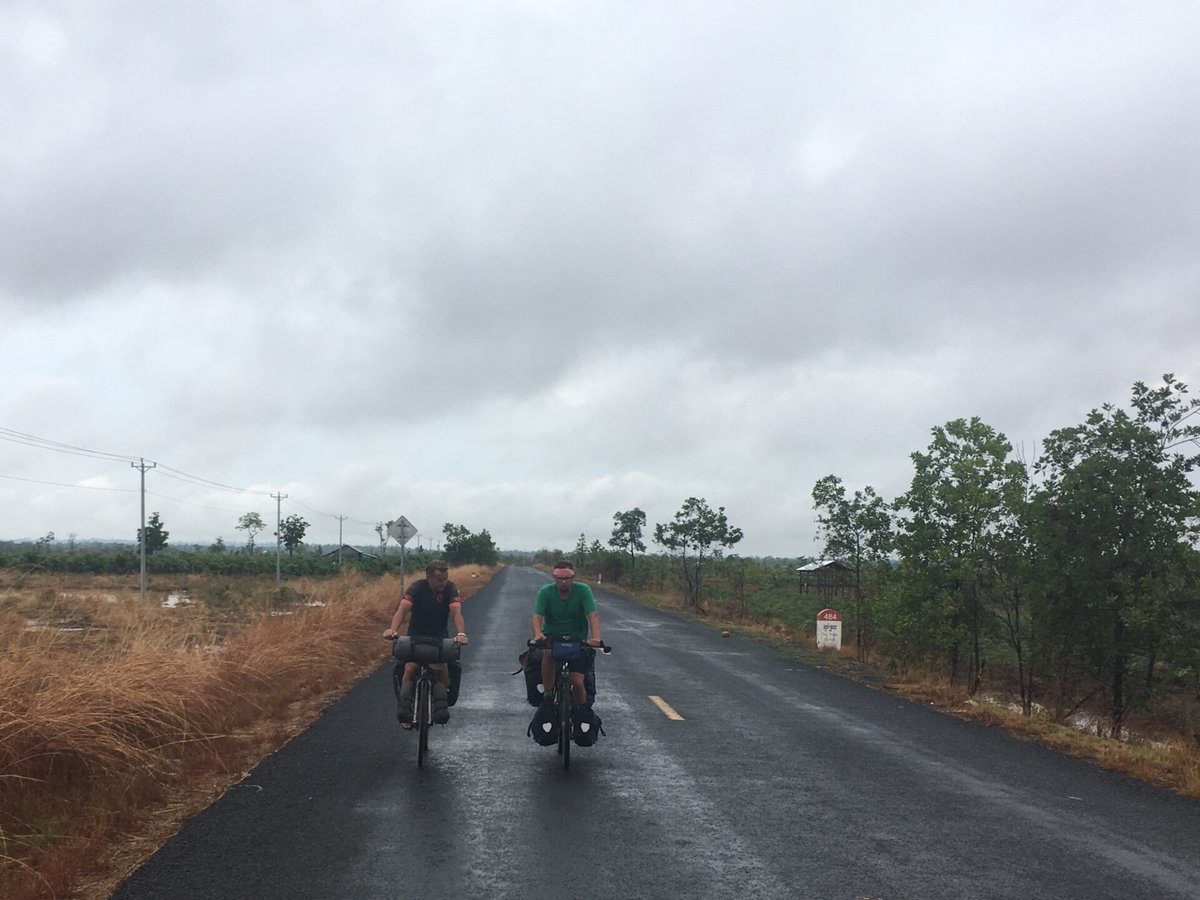
The rain stops, the clouds remain and the temperature is not too bad today, around 30 degrees. Millions of flies were born due to the rain of recent days and form a cloud above the road. They are quite lousy pilots and many die when the bump into us. Our front turns black, our hair is full of them. We regularly pause and see that the distance to Preah Vihear, which is indicated on the roadside milestones, continues to shrink. Yes yes, we are going to make it! At least we think so when we get lunch in the village of the filthy guest house. We use the restaurant’s wifi to select some guest houses. We read in one of the reviews that the reason for visiting the town is a temple with the same name “Preah Vihear”. If it is worth visiting, we could visit it the next morning and then cycle a short distance, or even just stay an extra day in the town.
We are very pleased to arrive at the guest house in Preah Vihear when the afternoon is about to end. Stefan checks in at the same guest house and gets the room next to us and again the three of us go out to get something to eat. We are looking for the place that is the only one selling pizza. According to the cycling computer today> 5000 k calories were burned and then a pizza goes in well. The body cries out for savory, greasy and, above all, a lot! Unfortunately the restaurant appears to be closed, but next to it is a restaurant with a local menu, also in English and we have the table filled with dishes and then attack. After the hunger has been satisfied, we check that temple mentioned in the review on internet and get to know that the Preah Vihear temple is 115 km to the north, close to (or almost on) the border with Thailand. Not really suitable for an early morning visit by bike. We also find out that the town we are in, is not named Preah Vihear officially, but Phnom Tbeng Meanchey. Well ‘Preah Vihear’ has been on the milestones for about 145 km and we keep calling it so.
From Preah Vihear to Siem Raep there are two more stages, one of 55 kilometers to a village near Koh Ker temple and one of 112. In the second stage we take a shortcut and turn off the main road, which would reduce the day distance to 98 kilometers. The first five kilometers of that shortcut are nice to cycle: the red gravel road through villages and jungle is fun and beautiful and the people along the path greet us cheerfully when we pass by.
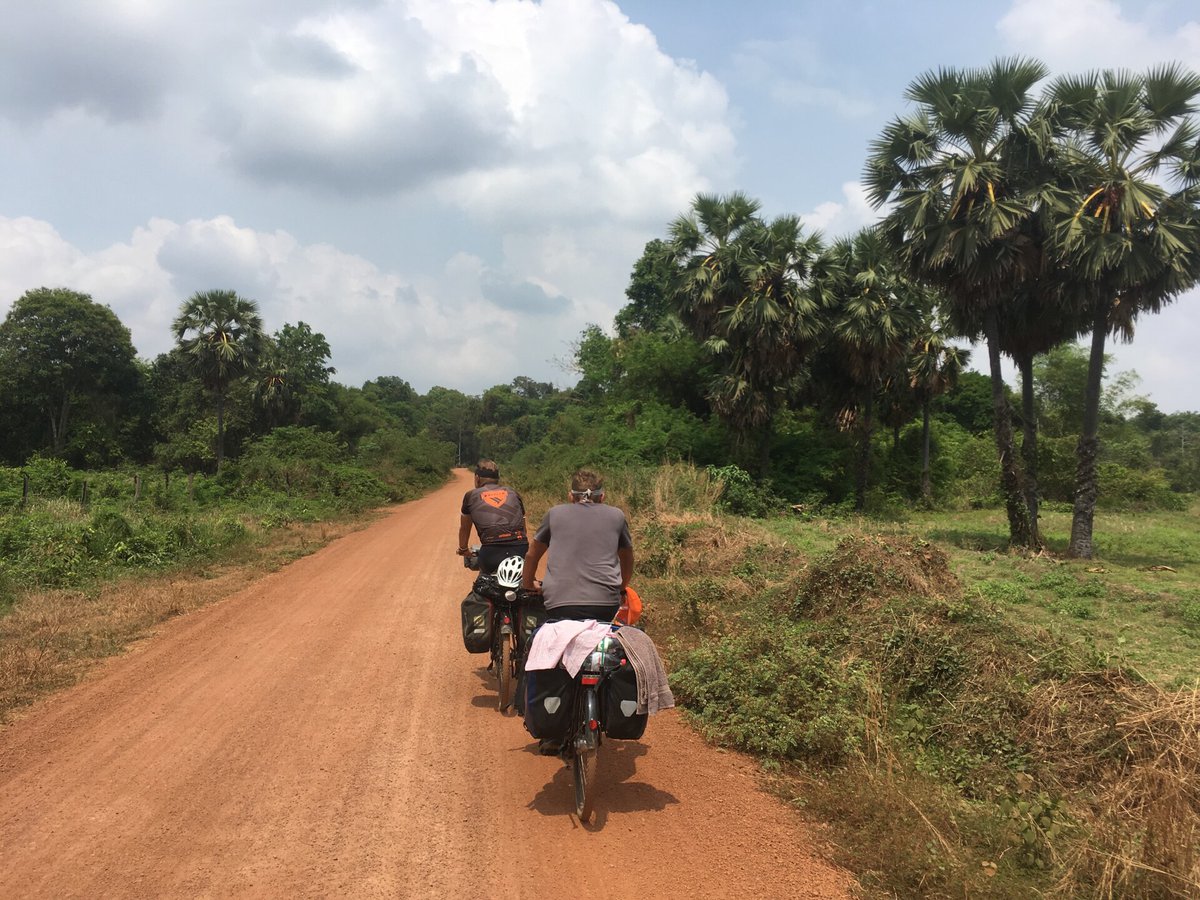
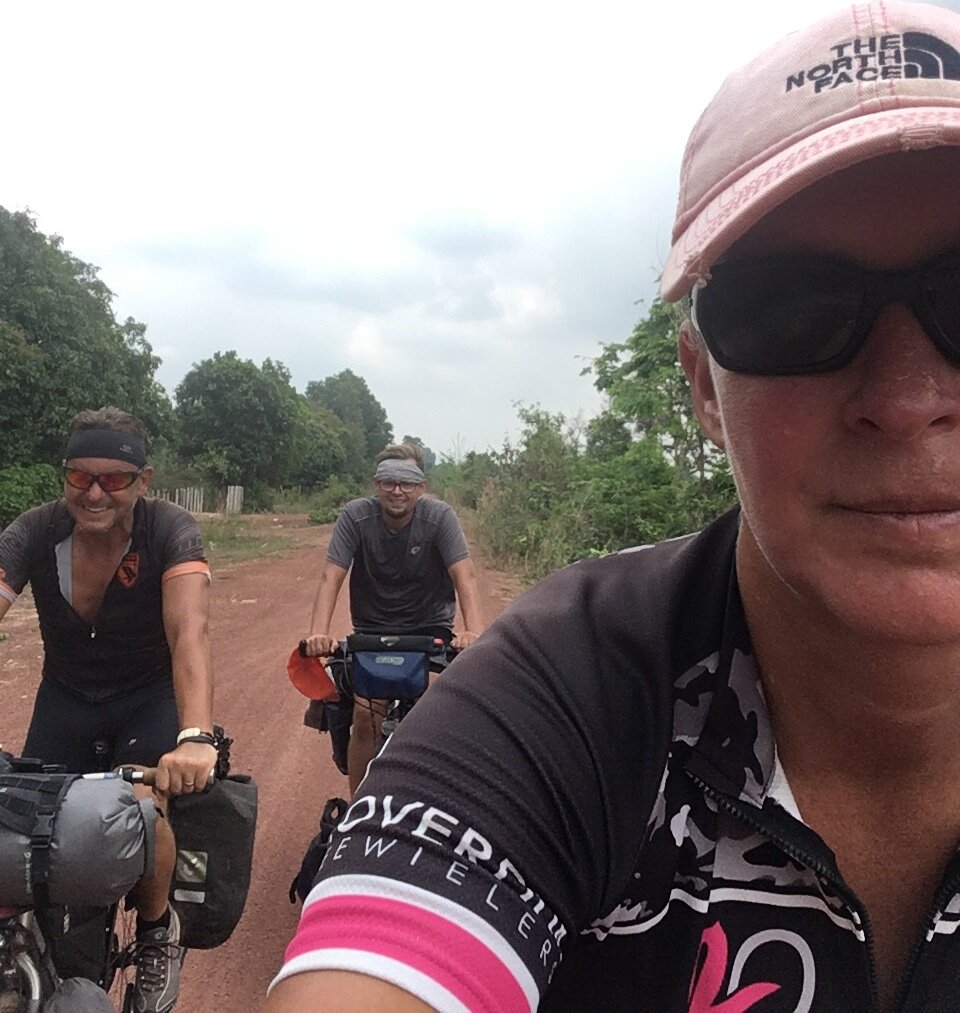
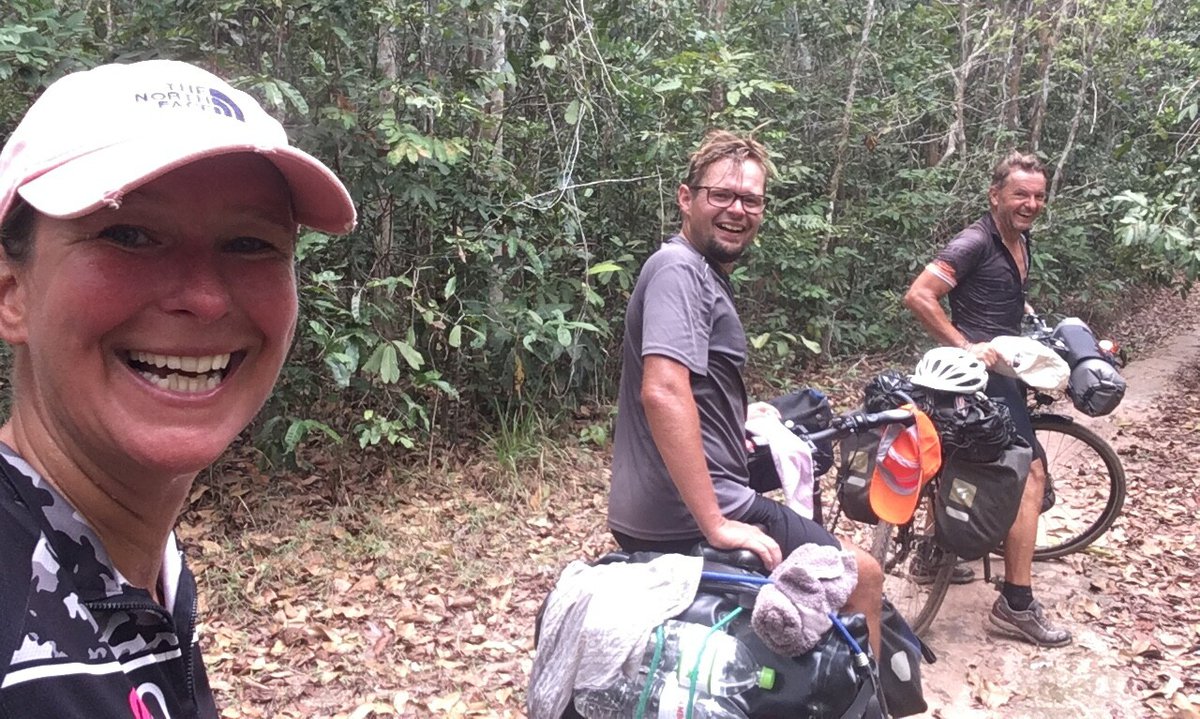
The trail then becomes a single track and then a remainder of a trail that also functions as a creek during the rainy season. It is no longer possible to cycle and thick mud accumulates between the wheel and the mudguard. Again a shortcut suggested by cycle route apps causes a lot of cursing and eventually crying out never to follow the route apps again. We need to push the bicycle and lift the rear wheel while walking. The path is full of leaves and we are aware of warnings that it can cover up snakes. We also fear other vermin as we make our way through the bushes growing over the path. After a few kilometers we can cycle again and the first thing we encounter when we get out of the bushbush is a scooter-wash. The owner speaks surprisingly well English and tells us that some tourists also try the jungle route on scooters, but return quickly. Strategically a good place for a scooter wash and very nice to rinse the bicycles and ourselves. The owner says that we did not had to worry about the snakes. They are some, but they are small and non-venomous, but there are still a lot of mines around there… okay …!
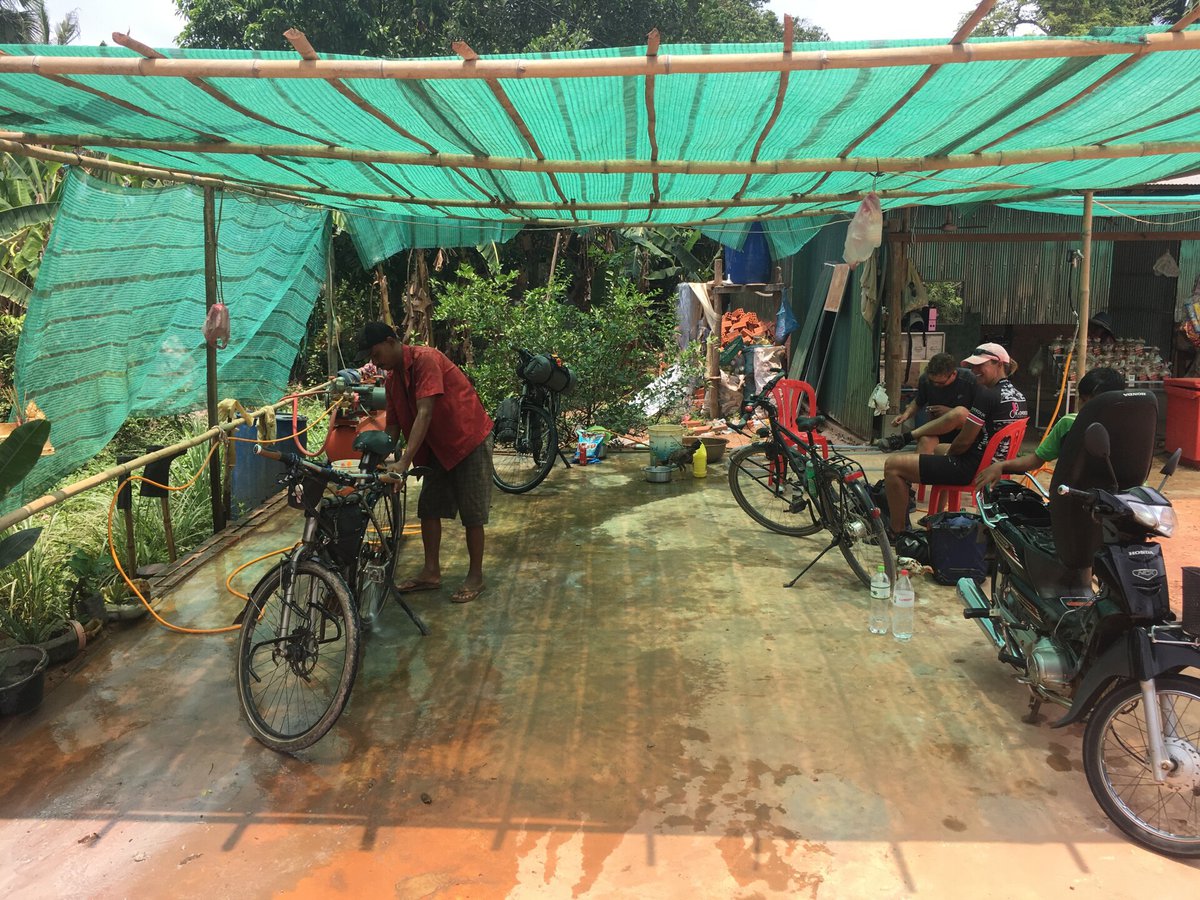
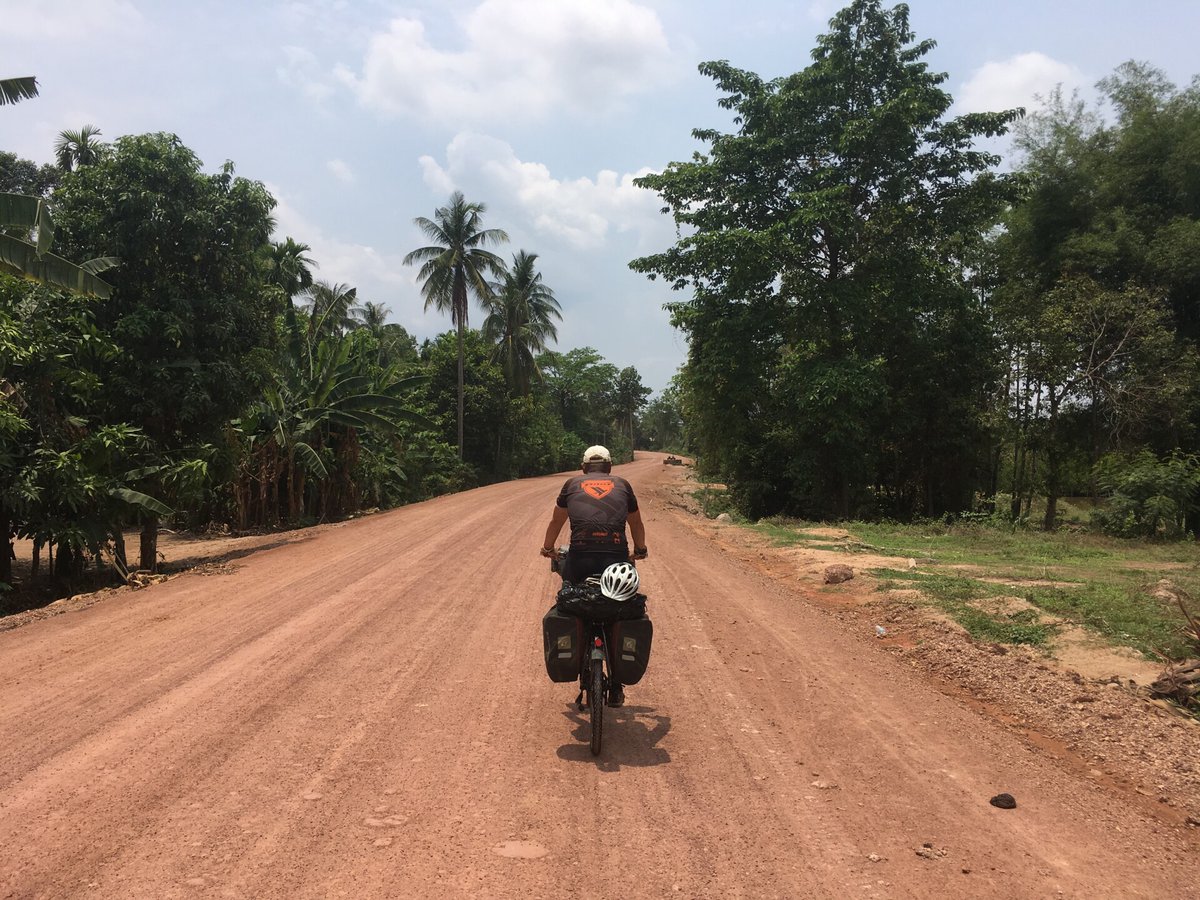
In the end and in the heat we cycle another 17 kilometers on the busy main road to Siem Reap and end up on a terrace to say proper goodbye to Stefan after four pleasant days of cycling together. His eye fell on a different guesthouse. Although one factor in choosing a place to stay is decisive for all of us in this heat: there must be a swimming pool.
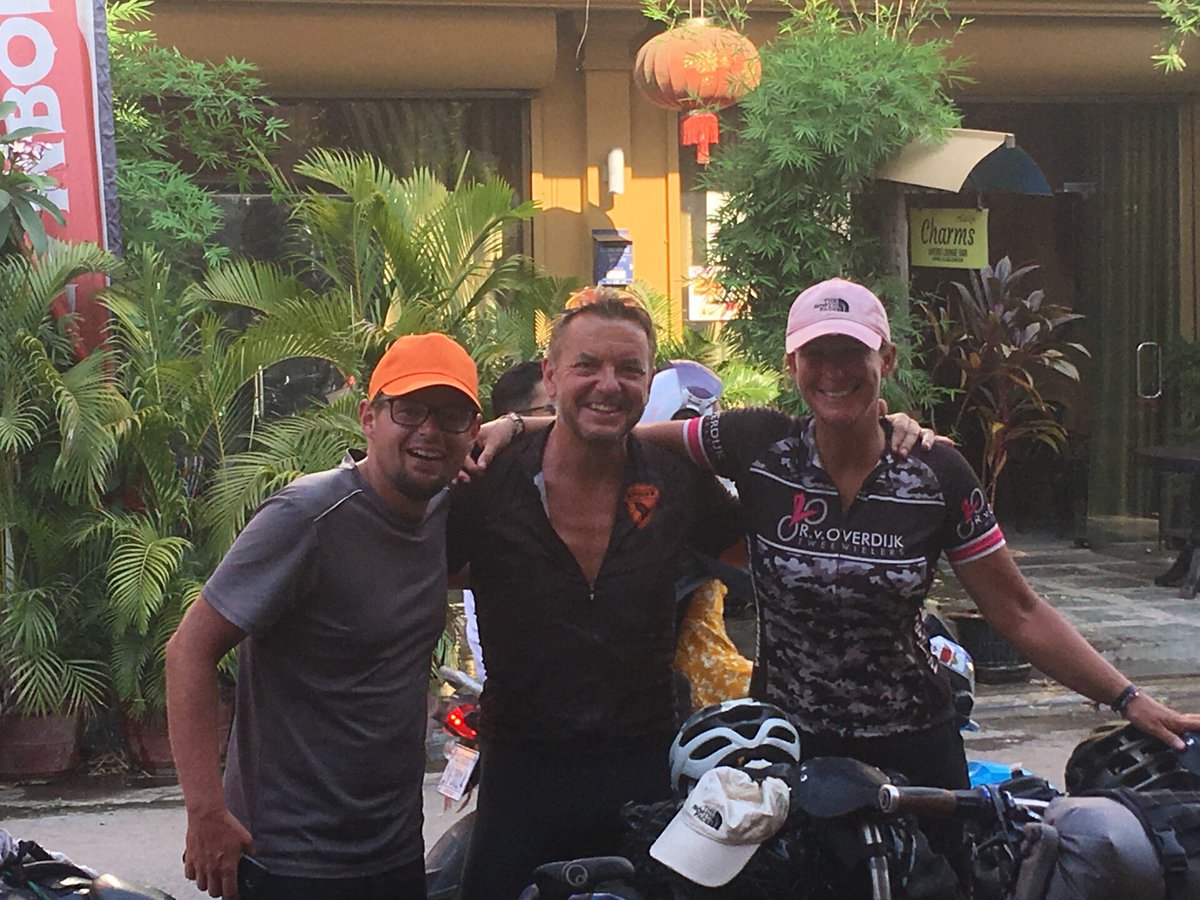
After a day of relaxing and bathing Roelie feels a bit displeased, while relaxing and bathing should have the exact opposite effect. We know that there is only one remedy and that is talking about it. Is it because of the unsuccessful attempt to score a nompang, the delicious baguette? The street vendors seem to be banned from the city center and after an hour of searching she finds an Asia Market that sells French baguette and Dutch cheese. No, that’s not it. Roelie suspects it is because of our intended visit to Angkor Wat. It is a “must see” and is on our schedule for tomorrow, but if she’s honest she doesn’t want to go. It is 10 km cycling and costs $ 37 per person to enter. The area around the temples is large and probably about 30 km of cycling. There are at least 3 temples to visit: Angkor Wat, Angkor Thom and a third of which we have not saved the name. A temple is a good hour’s walk and stair climbing. Everywhere and always it seems to be overloaded with tourists (on Google almost 300,000 photos have been uploaded of Angkor Wat temple). Oh and so it’ll be near 40 degrees (in the shadow). Harry didn’t feel like it at all, but had kept that to himself. The decision not to go was then quickly taken. Just an extra day at the pool and just nixing! The mood improves rapidly!
We end up staying for six nights in Siem Reap without visiting Angkor Wat and the other temples. We do watch a BBC documentary about Angkor on YouTube and afterwards know a lot more about it than what a bike tour would yield. We learn the name of the third temple and most appealing is Bayon, temple of the face towers. What we will be missing is the overwhelming impression that you get when you stand there.
We find a very pleasant routine to manage the heat. In the morning we do something such as groceries, market visit, bike shop or bike cleaning but around 12 o’clock there will be a coconut milkshake and a little later a baguette with Gouda cheese at the pool area where other guests rarely hang out. At the end of the afternoon we watch a film in our room with the air conditioning. In the evening we go out to eat somewhere in the city centre.
On one of the afternoons the electricity fails in our hotel. We are already used to it in Cambodia (and Laos), but now the problem seems persistent and long-lasting. When it gets dark outside, the electricity has failed for five or six hours. It is quite hot in our room, so the option “let’s go to sleep” is doomed to failure. The the water pressure has also disappeared, and we decide to check how the rest of the center is struggling with the problems. We see lights on the Night Market and continue to Pub Street: a street that comes to life when we are already in bed. The many generators keep things going here: the music blares out of the boxes, a large part of the lights are on and the beer flows cold from the tap. Instead of our ritual dinner, we soon sit down with our umpteenth beer, the hunger disappears and the dance floor on the other side beckons us. Exceptionally late (by midnight) we return to the hotel where the electricity has not yet fully returned, but the water pressure is back. We rinse the sweat off and are happy as teenagers that we did some dancing like back in the old days again.
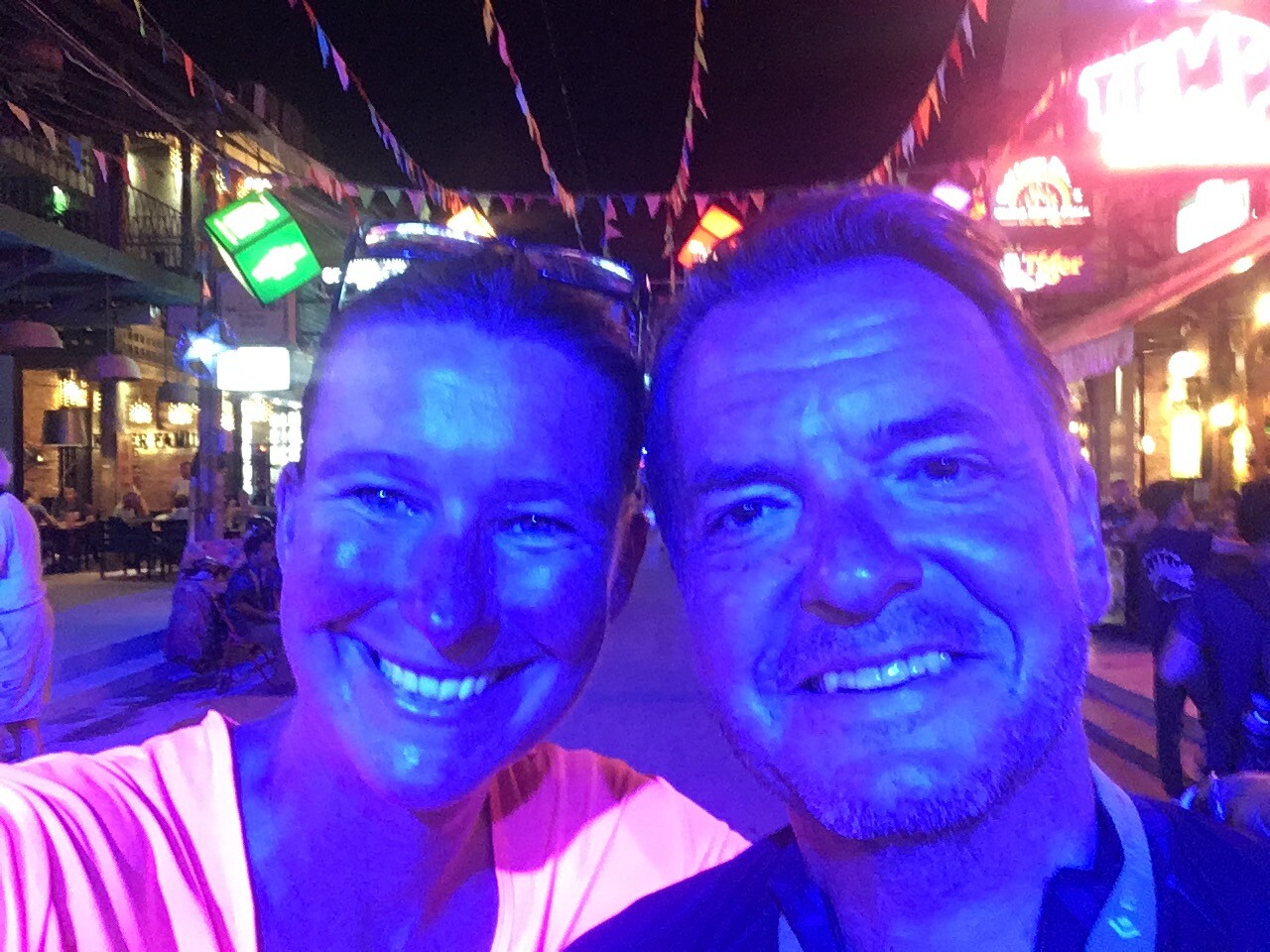
There are two routes from Siem Reap to Bangkok. One is the shortest and probably most boring: a straight main road leads from Siem Reap to the west. The other is mentioned to us in Laos by Andrew and Alison, a couple from Toronto and runs through the Cambodian towns of Battambang and Pailin. We believe it to be nicer until we find out that Battambang is a long way to cycle: about 75 kilometers as the crow flies but about two days of cycling (100 km each) on boring main roads: especially in this heat, no nice prospect. There must be another way: by boat. We will do that. The pier is 10 kilometers south of Siem Reap and the boat departs daily at 8 AM. As we arrive, a man at the pier tells us that today the boat left elsewhere and earlier than normal. The ticket lady, on the other hand, simply points us to the pier, but if she wants to sell us the tickets, the pier man spoils it and the tickets remain stuck in the ticket booklet. We are outraged. The hotel we stayed in got in contact the previous day to inform us and nothing was said about a different departure location or departure time. Well, maybe not so strange, because the ticket lady apparently didn’t know about it. We continue to insist to get to Battambang by boat. The man, who to us doesn’t have a clear function, uses his cell and tells us a little later that we are being taken to the big boat with a small boat. The tickets are torn off and we fold ourselves in the small boat that also carries our bikes and a Cambodian family. Once on the lake, the skipper shows how fast his small boat (with apparently a big engine) can do. In “planee” we glide over the green algae and in no time we are next to “the big boat” to transfer.
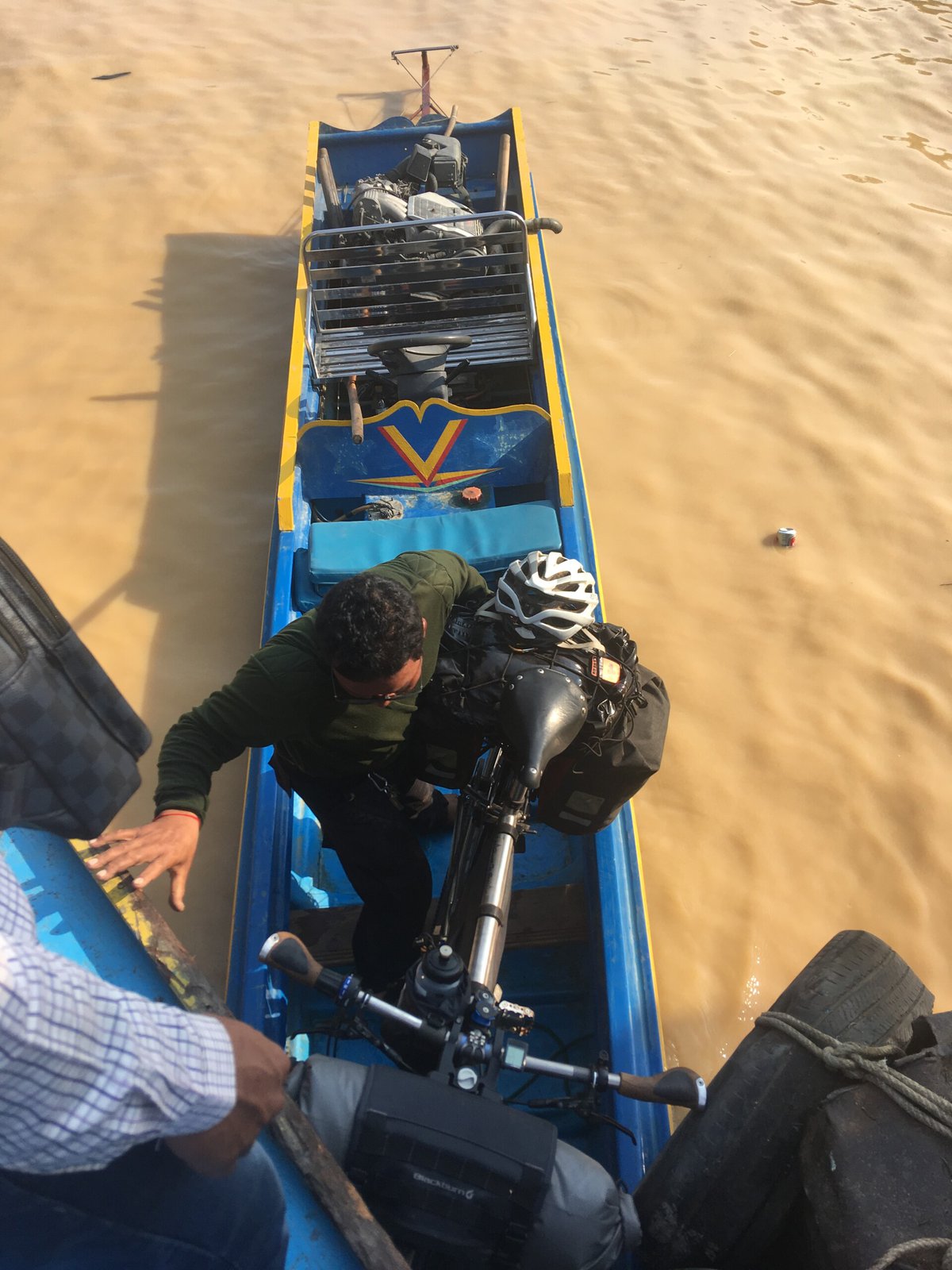
The large boat has a Norwegian family on board. They were also taken there by a fast small boat, and also left the harbor near 8 AM, but okay no bother we are on the move. On this boat we sail up the river. The floating villages we sail through are fascinating. The floating houses are often brightly colored, built with whatever is available and almost everyone seems to be selling or trading something. The houses float on old empty oil barrels or a whole package of bamboo stems. Occasionally a few passengers from the villages arrive and board as well. We see a lot, a lot of water hyacinth. The paddle of the boat has to go backwards repeatedly to get rid of the plants. With high bamboo constructions, nets are hung for fishing. At the end of such a construction is a super small hut. Most are neglected and out of use, but when laundry is hanging outside to dry it signs that the huts are still inhabited.
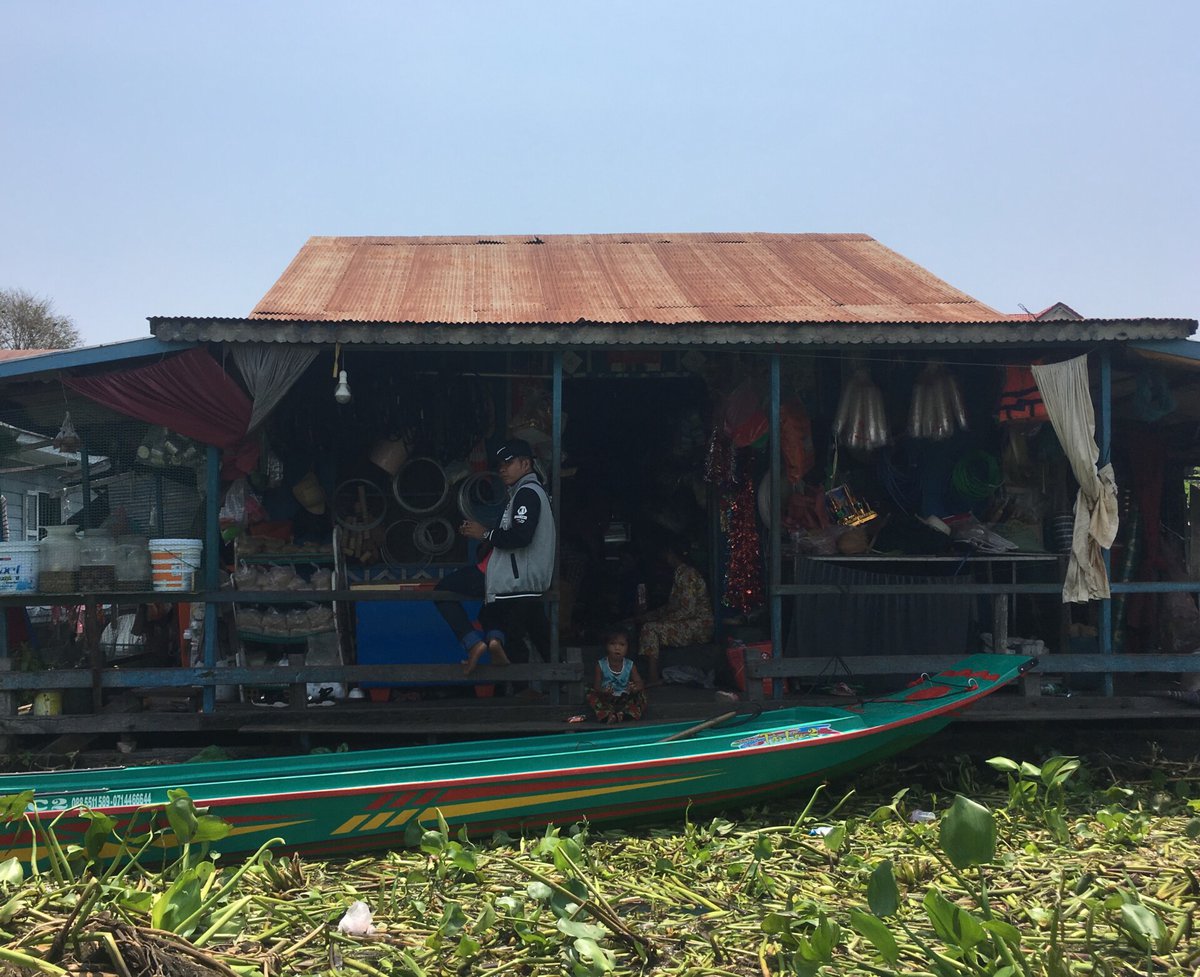
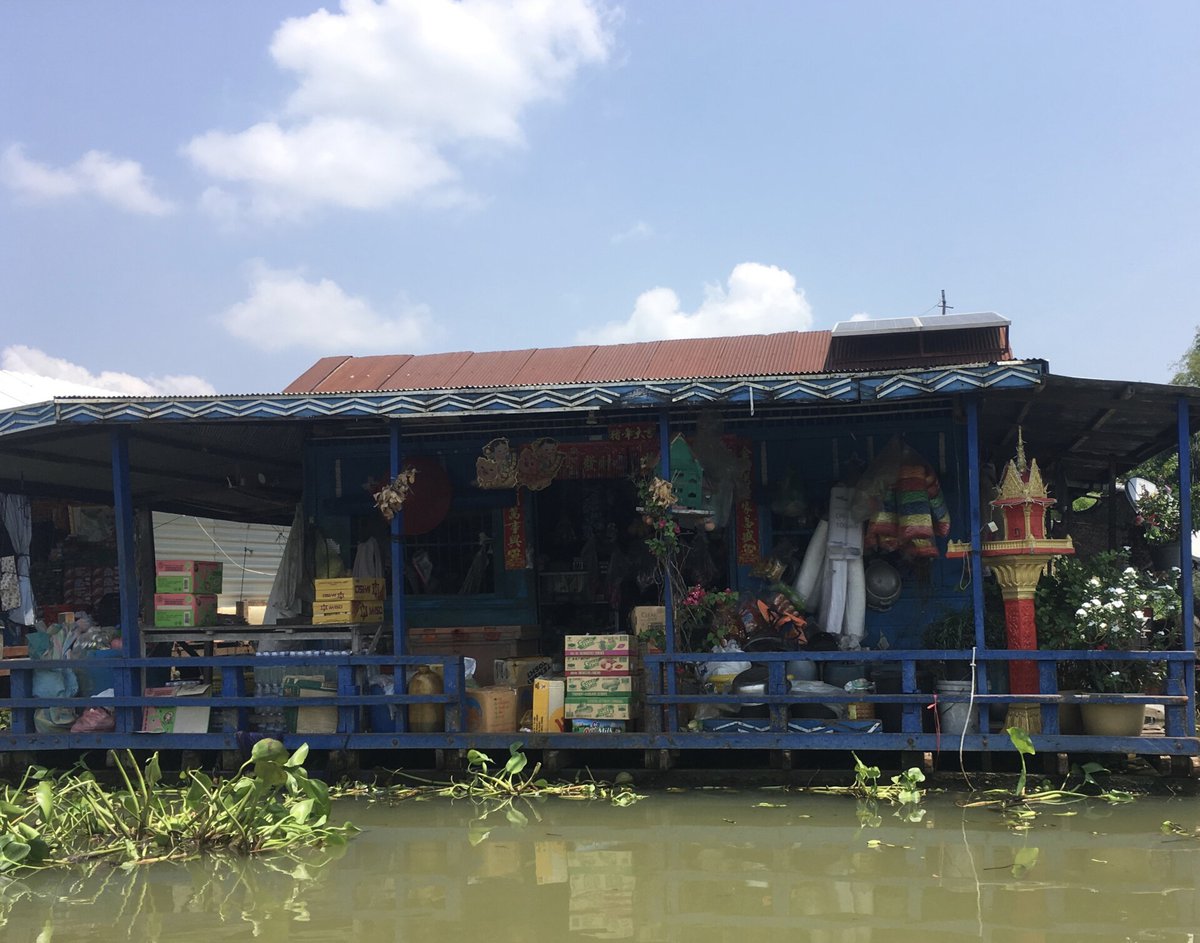
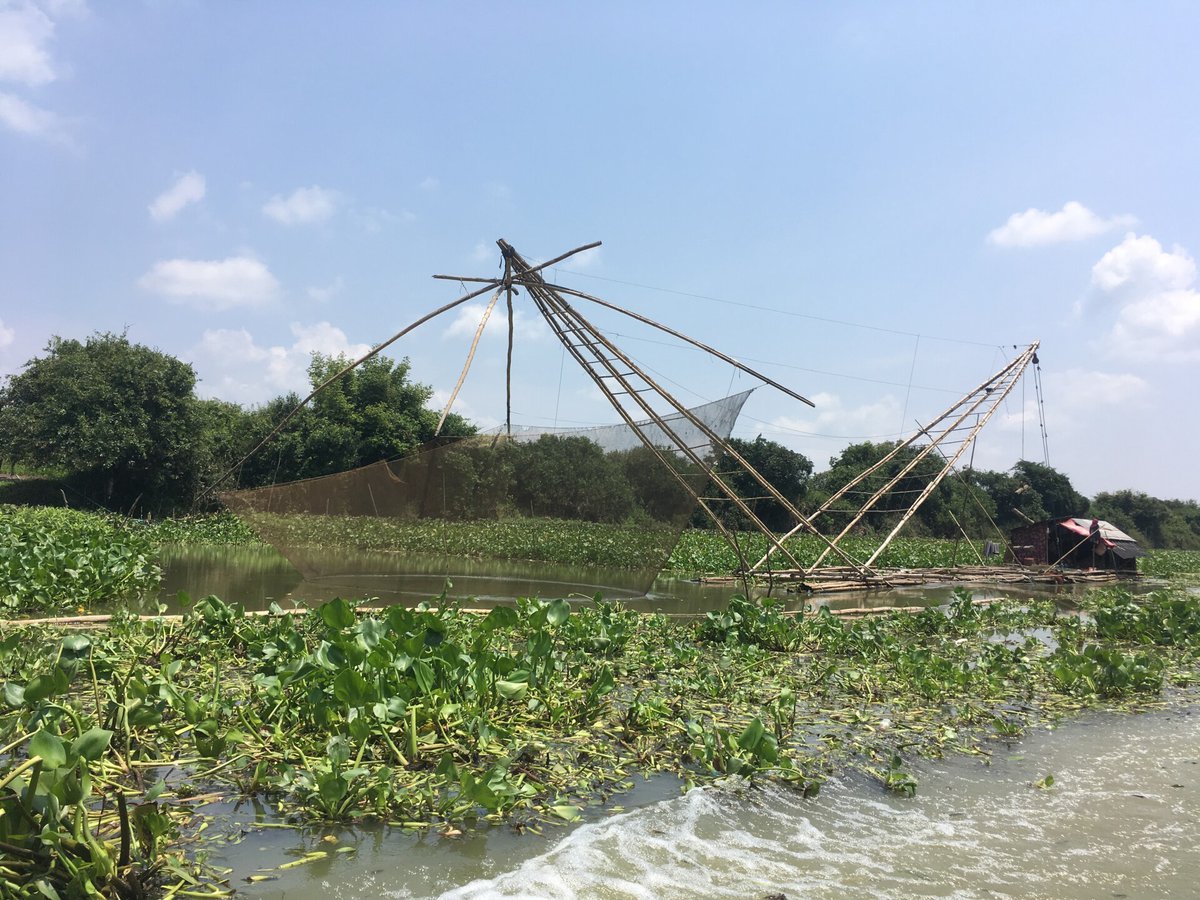
After three hours of sailing the skipper moors and tells us to go ashore for 30 minutes for a break. After 30 minutes the skipper tells us that he has called a bus. The water is too low to sail further up river. Route apps tell us that it is still 46 kilometers to Battambang and that is pretty far away in the heat of the day. We heard it is a “bumpy road”. We are curious whether the bicycles can get on the bus. The skipper says it is possible and that the very last part of the remaining road can be cycled, if we wish. We like to go by bus. The bus turns out to be an old Toyota hillux pickup. The tailgate becomes a bicycle carrier for one bicycle and the other bicycle is tied down with ropes, hanging in a vacuum. Beams are tied on three sides of the load box on which the adults can sit. The children try to keep their balance in the middle on top of the pile of luggage (including our panniers). In the end, around twenty people are stowed in the poor Toyota. The farangs (white foreigners) are invited to join the driver in the cabin. Because there is not enough space in the cabin one of the foreigners needs to sit in the back. To keep an eye on the bikes, Roelie takes a seat between the locals and the luggage. The road is very bad, very bumpy. We bounce in all directions and in the back we dive into the box to avoid the branches. Roelie sees how the panniers and we bounce up and down en masse. One of the panniers contains a laptop. The bar slides slowly between the spokes of Harry’s bike and Roelie fails to push the wheel away when it bounces during the bumps. She asks to stop the pickup. The driver tides an extra rope and says it’s okay now. We continue, but it is not going well. It is a matter of time until the laptop is broken, spokes burst and who knows what other damage is to expect. She asks to stop again. We take the bikes off. We will cycle. It is less than 40 kilometers.
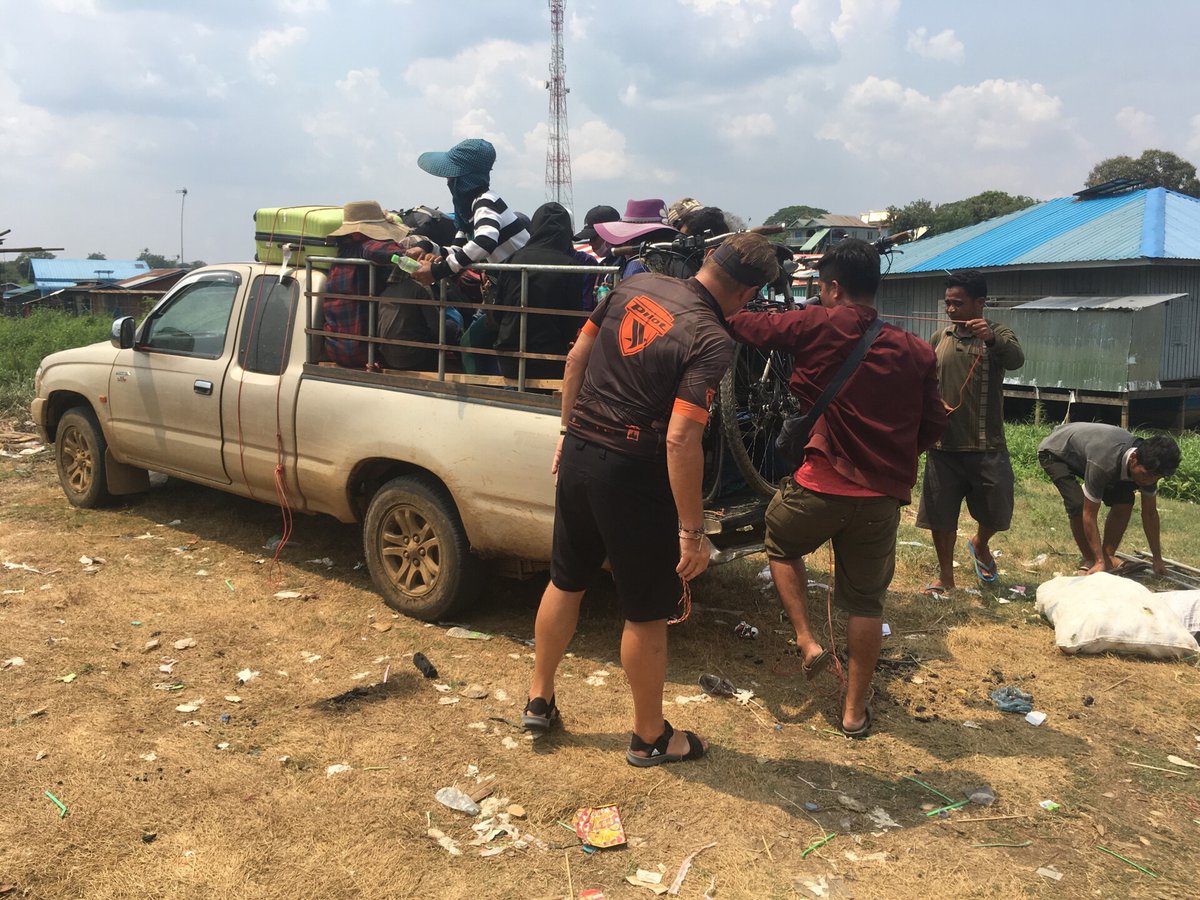
After a few meters the road gets worse and the cart tracks is filled with slippery wet mud. That probably happens often because next to the cart track, a bit higher up, is a scooter track. Some parts of the scooter track are also slippery, bumpy, narrow and plants have nasty thorns. Sometimes we need to push the bike and we scratch our arms and legs. An English speaking scooter driver tells us that after 300 meters the road gets better. Fortunately, the man is right. The road is getting better. We get back on the cart track and “make meters”. However …: dark clouds are gathering together in the direction that we need to go. It is not allowed to rain, we will never make it to Battambang. The tropical substrate of this path becomes putty immediately when it gets wet. We cycle as fast as we can while Harry’s rear wheel gets stuck in clogged mud, but he will and must and wants to get Battambang before the rain comes. An uneven battle, because the road was long and the rain was close. It starts with a rain shower, turns into a storm and ends in a tropical shower.
We are grateful to the lady who warns us about the tropical shower and offers us a hiding place. While we hide we do not feel completely at ease. The lady runs an ice trade and two boys unload a truck full of huge blocks. Thunderstorm or not, they continue their work undisturbed. We also see children cycling through the heavy rainfall and without the mud sticking to their wheels. How is that possible? Is it a matter of more weight, or is it due to the profile on our tires?
Either way the mud sticks especially to Harry’s rear wheel, and it then accumulates between the mudguard. The wheel then crashes. With sticks, which constantly break, we try to get the mud off again, but soon the space fills up again and cycling is impossible. We think we are stranded by the friendly ice lady. In gestures and with photos we try to get information from her as to whether the road is paved further on. We don’t understand the answer, but our uncomfortable feeling nevertheless sends us back onto the road when the thunderstorm comes to an end. It is 5 o’clock and we still have 22 kilometers to go to Battambang. The first kilometer is going well, the second is drama again. From the third kilometer there are quite a lot of puddles on the road and cycling through the puddles is slightly better. As if we are toddlers jumping in the puddles, we search the way to the track with the most puddles. And after 5 or 6 kilometers of plowing through mud and puddles and many stop and scraping actions, we arrive on a paved road. We dare not to cheer, because you never know how long it will take, but it lasts, even all the way to Battambang.
It is dark when we cycle into the partly flooded center and not just because the sun has set. Also the power has failed. The Star hotel, our first choice to stay overnight, is not visible from the street. We cycle on until we arrive at a part of the city where the electricity is working. A man walks unto the street and yells “Royal Hotel”, the name of the hotel he stands for. Due to the low season we can get a nice room there for 15 dollars, “special low price for you my friend”. He drags us across the street to wash the mud off our legs and feet and offers to rinse our bikes. Still smelly and with dirty clothes we eat across the street. All the guests leaving our hotel cross the street to this restaurant, so it will be fine. Out of good decency we sit down at some distance from the other guests and get a beautiful Italian menu and celebrate that we have achieved Battambang with (real Italian) pizza!
The next and final stage through Cambodia takes us to the town of Pailin. In principle it is not very far (85 km) and also not very many altimeters (330 m up) but we still have a hard time with it. Did we mention it is hot in Cambodia? We don’t know, we can’t think clearly anymore. For a moment we have the idea that we can finish the 85 kilometers well before 1 pm, but Harry gets a flat tire after about 50 km and we can’t find the cause. We put a new inner tube around the rear wheel and cycle 100 meters until the tire is completely flat even in a short time. How is that possible? A second inspection of the tire and rim again provides no cause. We pump up the new inner tube to find where the hole is. It deflated so quickly, perhaps even without water the hole can be found and it works. The new inner tube is torn on its seam. A tiny iron wire from a truck tire cannot be the cause of that, this must be a manufacturing fault of Bontrager. We bought four more of that type of tire, all in Yangon, Myanmar when we had a lot of flat tires. Since then we have not had a flat tire and therefore do not have to test these tubes. We do not dare to use another one and opt for a good old Schwalbe tube that has been repaired several times. It brings us to Pailin, our last stop in Cambodia. From here another 19 kilometers to casino village Prum on the Thai border and then Cambodia is already behind us. If we could just leave those stifling high temperatures behind us! What we will not leave behind is the Songkran Festival, the New Year’s party. It is celebrated in Laos, Cambodia and yes, also in Thailand and starts today. The festivities lasts three days and are mainly known for the mutual hilarious water fights. For weeks we have seen huge ‘super sookers’ along the road, next to the bananas and the bags of chips. This morning before we left, the receptionist predicts a ‘wet suit’ because we are not expected to be spared. Yes, refreshing! What is less fun is that the festival is also known for the annual number of road deaths. The Thai police indicate that these days are the most dangerous days of the year to hit the road. We will be sprayed nice and wet, but at the same time we have to be careful that we are not driven off our socks by a drunk driver.
Okay Roelie, wave one more time: bye Cambodia, bye lovely people; it was pleasant to visit you, but you are so hot!
